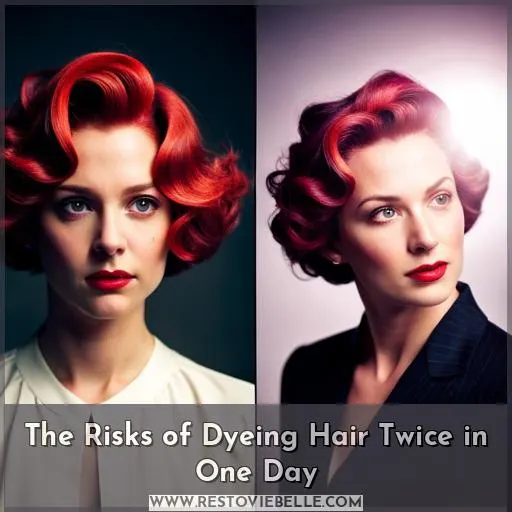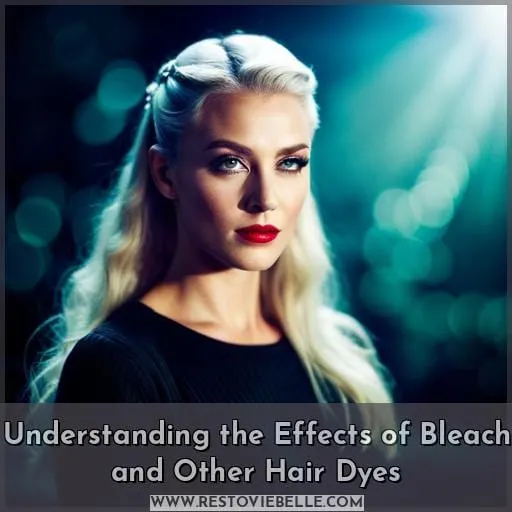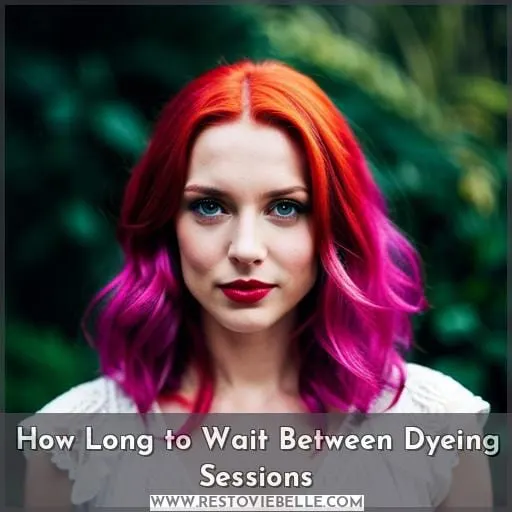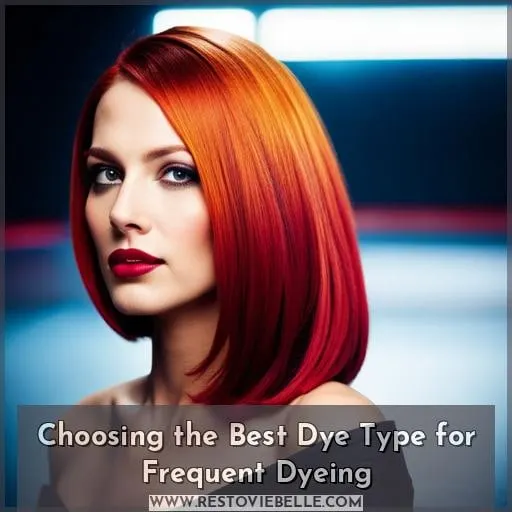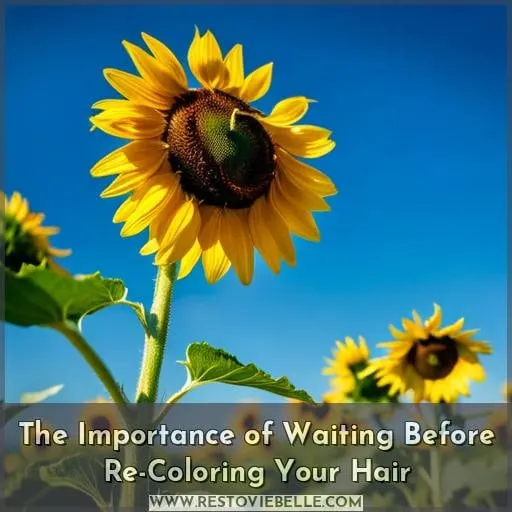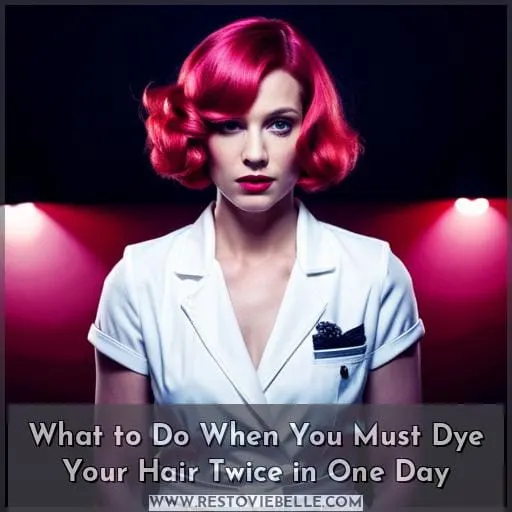This site is supported by our readers. We may earn a commission, at no cost to you, if you purchase through links.
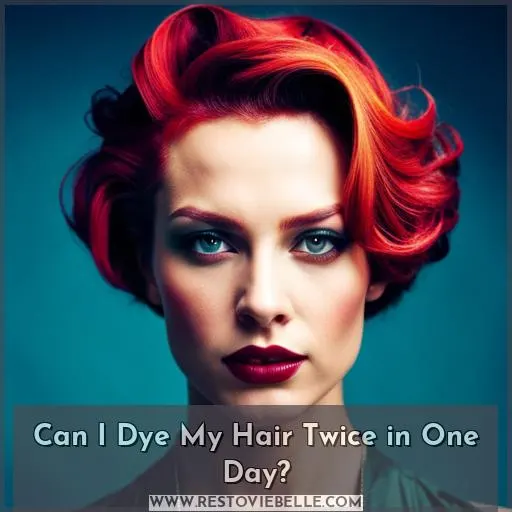 By now, you’ve likely asked yourself the dreaded question: can I dye my hair twice in one day? We get it. You want your color to be perfect and sometimes that means another round of dyeing. But before you take this leap, there are some risks associated with frequent coloring that could damage your tresses beyond repair if not done correctly.
By now, you’ve likely asked yourself the dreaded question: can I dye my hair twice in one day? We get it. You want your color to be perfect and sometimes that means another round of dyeing. But before you take this leap, there are some risks associated with frequent coloring that could damage your tresses beyond repair if not done correctly.
To help protect against this outcome and ensure a successful double-dye session, let’s explore what happens when we attempt to transform our manes more than once in one day – starting with understanding the effects of bleach or other hair dyes on our locks!
Table Of Contents
- Key Takeaways
- The Risks of Dyeing Hair Twice in One Day
- Understanding the Effects of Bleach and Other Hair Dyes
- Comparing Permanent and Demi-Permanent Dyes With Semi-Permanent and Temporary Dyes
- How Long to Wait Between Dyeing Sessions
- Choosing the Best Dye Type for Frequent Dyeing
- Tips on Repairing Dye-Damaged Hair
- The Importance of Waiting Before Re-Coloring Your Hair
- What to Do When You Must Dye Your Hair Twice in One Day
- Conclusion
Key Takeaways
- Risks of dyeing hair twice in one day include potential damage, allergic reactions, and uneven results.
- It is important to choose the right type of hair dye, prioritizing hair health with gentler options like semi-permanent dyes.
- Wait times between dye sessions vary depending on the type of dye used, with permanent dyes requiring 6-8 weeks and semi-permanent dyes requiring only 48 hours.
- Proper hair health maintenance, including regular trims, deep conditioning treatments, and protection from UV rays and heat styling, is essential for vibrant and healthy hair.
The Risks of Dyeing Hair Twice in One Day
You should be aware of the potential risks before attempting to color your locks twice in a single 24-hour period. Rapid dyeing can cause significant damage to your hair due to the harsh chemicals present, as well as put you at risk for chemical reactions and allergic contact dermatitis.
Overuse of bleach or ammonia-based dyes can strip away natural oils from the scalp and lead to dryness, breakage, split ends, and discoloration.
Hair that has been dyed multiple times is also more prone to fading faster than normal since it lacks many protective layers on its surface. Double dyeing may also result in unpredictable results such as staining or patchy coverage which could leave you with an uneven finish along with brass tones that need correction afterwards using blue shampoo or toners like Wella Colorcharm Toner T28.
When considering double dyeing within a day’s time frame, always prioritize hair health first by opting for gentler coloring solutions instead like semi-permanent dyes over harsher chemicals found in permanent color products.
Understanding the Effects of Bleach and Other Hair Dyes
It’s important to understand the effects of bleach and other hair dyes if you’re considering dyeing your hair twice in one day. For instance, someone with naturally dark brunette hair may struggle to achieve a bright blonde color by bleaching their locks twice in a single day – they should instead opt for lightening gradually over time.
- Bleach Effects: Bleaching can cause extensive damage if done too often or without proper care between processes.
- Color Maintenance: Consider using toners, blue shampoo, temporary dye, and direct dyes like colored waxes for safer color correction options than double-dyeing during the same week.
- Hair Health: Opt for gentle coloring solutions such as semi-permanent and demi-permanent dyes when frequent coloring is necessary. Use protein-rich products or moisturizing treatments between sessions to minimize damage. Avoid brushing wet strands unless detangling cream or conditioner is used first. Protect from UV rays and heat styling tools while nourishing from within with water intake and supplements when needed.
Dye risks include unpredictable results due to natural color changes after multiple applications, chemical reactions that could occur due to miscalculations of timing limits on box instructions being followed incorrectly, possible scalp irritation while waiting out times prior before reapplying another layer of pigment would be safe enough not causing any further damages than already existing ones, as well as unnecessary losses caused through excessive washing offs which could lead towards heavy staining’s because it wasn’t taken into consideration how much product was left on beforehand.
When thinking about dyeing your hair twice in one day, just remember that it all boils down to understanding how far you want to go safely aside from what will ultimately look best at the end result after everything has been put together properly.
Taking into account preventive measures are better long-term solutions rather than relying upon corrective strategies, which might create more problems than actually solving them afterwards, especially once involved harsh chemicals such as bleach aren’t touched frequently but only occasionally under certain circumstances where it’s truly warranted.
So take precautions, plan ahead, consider the wait period required, and try different methods in order to receive the desired outcome wisely.
Comparing Permanent and Demi-Permanent Dyes With Semi-Permanent and Temporary Dyes
Compare the long-term effects of permanent and demi-permanent hair dyes with temporary or semi-permanent options to keep your locks looking vibrant and healthy for years to come.
- Effectiveness in Covering Grey Hairs & Lasting Time Frame: High coverage, up to 8 weeks before retouching required.
- Hair Damage Potential & Protection: Potentially damaging if used incorrectly.
- Cost: Generally more expensive than other types of dye.
Demi Permanent Hair Dye:
- Effectiveness in Covering Grey Hairs & Lasting Time Frame: Medium coverage, lasts 2 – 4 weeks before retouching is necessary.
- Hair Damage Potential & Protection: Can cause damage if left on too long.
- Cost: Cheapest option but may require multiple applications.
Semi/Temporary Options:
- Effectiveness in Covering Grey Hairs & Lasting Time Frame: Low coverage; usually washes out in 1 wash or less.
- Hair Damage Potential & Protection: Gentler on hair follicles; limited protection needed.
- Cost: Cheapest option but may require multiple applications.
Whether you’re wanting a bold new look that won’t fade over time or just want subtle color changes without harsh chemicals, there’s an option for everyone. For low maintenance coloring that will last a couple shampoos but can easily be changed up as often as you’d like, try direct dyes such as colored waxes, chalks, and sprays.
If longer-lasting results are desired, then semi-permanent solutions may be best suited. For those looking for a drastic change, permanent or demi-permanent products are the way to go.
Lastly, taking into consideration pre-existing knowledge about caring properly after coloring treatments is important since this will help prevent further harm done by dying twice in one day.
How Long to Wait Between Dyeing Sessions
When considering how often you should dye your hair, there are different considerations for permanent, demi-permanent, and semi-permanent dyes. Permanent dyes require waiting 6 to 8 weeks between applications, while demi-permanent colors can be reapplied every 2 to 4 weeks.
Semi-permanent color is a layer of pigment on the hair and requires at least 48 hours before being applied again. Knowing these time frames will help you achieve healthy results when dyeing your hair multiple times in one week or day.
Considerations for Permanent Dye
When using permanent dye, remember to wait 6-8 weeks between sessions for the best results. Protect hair health and prevent damage with regular trims and deep conditioning treatments prior to coloring.
To achieve desired color change goals, opt for toners or temporary dyes instead of bleaching twice in one week. Color correction methods like purple shampoo can help remove brassiness from dyed red hair, while blue shampoos neutralize orange undertones in brunette shades.
Considerations for Demi-Permanent Dye
Demi-permanent dyes are gentler on hair than permanent dye, so you can experiment with color more often without fear of damage. To get the best results from demi-permanent dye, consider your hair health. Pick a dye type suited to your desired change in color and wait appropriately between sessions.
For instance, use protein treatments or deep conditioners after every session if repairing damaged hair. Look for hypoallergenic products when treating colored locks. And wait at least two weeks before reapplying demi-permanent dyes for optimal results.
With expert advice and proper care for dyed tresses, plus the right kind of product tailored to each individual’s needs, one can explore different hairstyles safely!
Considerations for Semi-Permanent Dye
Semi-permanent dyes provide long-lasting color and are gentle enough for frequent use. You can refresh your look with a new hue every few days or go all out and mix multiple shades to create an eye-catching style.
Beforehand, research color theory tips and then consider home remedies for maintenance. An aftercare routine is essential to prevent hair breakage. Avoid bleaching twice in one week and trim regularly.
Semi-permanent dye can add vibrancy without damaging the cuticle. Find inspiration on Instagram! Protect your tresses from UV rays by using protective hairstyles, heat styling tools sparingly, silk/satin pillowcases, and nourishing supplements inside out for optimal results.
Choosing the Best Dye Type for Frequent Dyeing
When deciding to dye your hair twice in one day, it’s important to consider the type of dye that you use and take time limits and precautions into account. Semi-permanent dyes are gentler on the hair than harsher chemical dyes, but both can cause damage if not used correctly.
Additionally, always prioritize your hair health when using any kind of dye; regular trims and deep conditioning treatments with protein-rich products can help repair damaged strands.
Semi-permanent vs. harsh dyes
You must consider the type of dye you use if you plan to frequently change up your look. Semi-permanent dyes offer benefits such as conditioning and repair, plus they are milder on hair. However, harsh chemicals like bleach require precautions and can cause damage when used twice in one day.
For optimal results, prioritize hair health with treatments like deep conditioners or protective styles between dyeing sessions; direct dyes provide temporary color for frequent coloring without risking damage.
Time limits and precautions
Be mindful of time limits and take precautions when dyeing your hair frequently for the best results. Permanent dyes need 6-8 weeks between applications, while demi-permanent color can be reapplied every 2-4 weeks.
Direct dyes are the safest option to use often. Colored waxes, chalks, and sprays all provide temporary pigment without causing damage or chemical reactions with bleaching agents.
To protect your hair from UV rays, wear hats or use a UV spray protectant. Limit heat styling and brush only after applying detangling cream or conditioner on wet strands.
Opt for gentle coloring solutions like semi and demi-permanent dyes over harsh chemicals to keep your locks healthy.
Hair health considerations
When dyeing your hair frequently, prioritize its health and protect strands with deep conditioning treatments. Regular trims help remove split ends while keeping the length healthy. Protect from UV rays, limit heat styling, and use silk/satin pillowcases to reduce damage further.
Nourish hair from the inside out by drinking plenty of water and taking nutritional supplements as needed for deficiencies. Aftercare is key – condition after every wash session. Don’t brush or comb wet hair unless you’ve used detangling cream or conditioner first! Use gentle coloring solutions like semi-permanent and demi-permanent dyes that are less damaging than harsher chemicals in bleach and ammonia-based dye when going for frequent color correction.
Tips on Repairing Dye-Damaged Hair
Dyeing your hair multiple times can cause damage if not done correctly. To repair dye-damaged hair and restore its health, here are some tips to follow:
- Regular trims help get rid of split ends. Deep conditioning nourishes the scalp and lengths.
- Limit heat styling as much as possible. Use protective styles like wigs, braids, or twists when needed. Shield your head with UV protection hats when outdoors. Sleep on silk/satin pillowcases for an extra layer of defense against breakage.
- For color correction, toners, blue shampoos, temporary dyes, direct dyes (colored waxes, chalks), and purple shampoo provide solutions without harsh chemicals that could further damage weakened locks.
- Practice healthy haircare by nourishing from within. Drink lots of water to replenish dryness. Take supplements for any nutritional deficiencies you may have. When brushing or combing wet hair, avoid using brushes and opt for detangling cream or conditioner to reduce tugging on fragile follicles.
By following these simple steps, you are guaranteed results that leave your colored mane looking vibrant yet healthy! Prioritize haircare above everything else, especially frequent coloring sessions!
The Importance of Waiting Before Re-Coloring Your Hair
You can create beautiful, vibrant looks by taking time to wait between color sessions. Hair waiting is an important factor when considering frequent dyeing, as it helps prevent damage and unpredictable color results.
Re-coloring too soon puts the hair at risk of chemical reactions that may result in dryness or breakage. When attempting a drastic change in hue or tone, like going from dark brown to blonde for example, it’s best to take your time and lighten gradually with toners rather than trying to achieve the look all at once; this will help reduce any risks associated with re-coloring.
For those looking for more subtle changes without bleaching their hair multiple times a week, they should opt for semi-permanent dyes which are milder on the strands yet still provide good coverage after repeated applications over several weeks.
Direct dyes such as colored waxes and temporary sprays are also great alternatives if you want frequent coloring but don’t want permanent results; these products typically wash out within one shampoo session so there’s no need to worry about long-term effects on your locks!
No matter what type of dye you use, though, always be sure to protect your tresses by using deep conditioning treatments before each application and avoiding excessive heat styling afterwards—these small steps go a long way towards maintaining healthy, beautiful colored hair!
What to Do When You Must Dye Your Hair Twice in One Day
If you must double-dye your ‘do, use caution and choose a gentler option! Permanent, demi-permanent, and semi-permanent dyes all have different considerations when it comes to dyeing hair twice in one day.
To ensure the best results with minimal damage to your hair, opt for gentle coloring solutions such as semi-permanent or demi-permanent dyes.
For color correction or maintenance between salon visits, consider temporary options like direct dyes (colored waxes, sprays), toners, and blue shampoo treatments instead of using bleach or ammonia-based products that can be too harsh on the scalp.
When frequent dyeing is necessary, make sure to keep up regular trims. Also, use protein-rich products for repair along with deep conditioning treatments to help maintain healthy locks between sessions.
Protective styles like wigs, braids, and twists are great alternatives if needed. Ensure adequate water intake and consider supplements to provide nutritional needs not met through diet alone. Avoid brushing wet hair to prevent further breakdown of strands needed by the cuticle layer itself.
In summary, hair color maintenance requires patience combined with proper product selection tailored towards individual needs, including pre-existing conditions caused by previous chemical processes. Waiting before recoloring helps achieve desired results without risking further damage during experimentation.
This allows for more control over outcomes achieved upon completion, eliminating possible disappointment after finalization has been successfully completed.
Conclusion
Have you ever wondered if you can dye your hair twice in one day? It’s possible to do so, but it’s important to understand the risks and effects of bleach and other types of hair dye.
Permanent dyes require a 6-8 week waiting period between applications. Demi-permanent and semi-permanent dyes, on the other hand, can be used every 2-4 weeks and 48 hours respectively. Direct dyes, like colored hair wax, hair chalk, and temporary color sprays, are the best option for frequent dyeing since they are temporary and gentle.
When dyeing your hair, it’s best to wait for optimal results and prioritize hair health. Remember to use protein-rich products and conditioning masks between coloring sessions.
With careful consideration, you can dye your hair twice in one day and achieve the results you desire.
